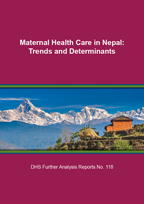There is no printed copy available to order.
Abstract:
Despite the longstanding efforts of the Ministry of Health and Population (MoHP) in Nepal to promote maternal and neonatal health (MNH), progress has been slow for MNH service use. This analysis aimed to identify determinants of maternal health care use: antenatal care (ANC) visits, institutional delivery, and postnatal care (PNC) check-up. We analyzed 2011 and 2016 Nepal Demographic and Health Surveys (NDHS) data to illustrate the trend of these three outcome variables, and 2016 NDHS data alone for determinants of the outcome variables. The number of women included in the analysis was 1,440 for ANC, 1,478 for place of delivery, and 718 for PNC. We used descriptive and inferential statistics and presented the results as proportions and adjusted odds ratios.
Since 2011, we observed a substantial increase in the proportion of women with four ANC visits and institutional delivery, but only a small increase in PNC check-up. Lower birth order was associated with the ANC visits. Better education, completion of four ANC visits, and birth preparedness were associated with institutional delivery. Having institutional delivery and receiving advice for PNC check-up was associated with PNC check-up. We found an association of all the outcome variables with wealth quintile and province.
These findings suggest that women marginalized by geography, wealth, and education are less likely to access maternal health care. To achieve the goals of increasing the institutional delivery rate to 70%, and of increasing ANC visits and PNC check-up to 90% by 2020, more focused interventions, targeting the underserved and most marginalized population, are required.
 Maternal Health Care in Nepal: Trends and Determinants (PDF, 3644K)
Maternal Health Care in Nepal: Trends and Determinants (PDF, 3644K)
